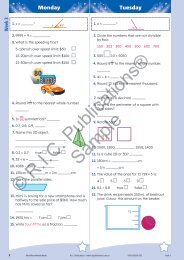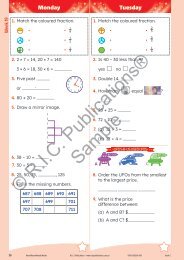PR-0552UK Primary Science - Book 2
Create successful ePaper yourself
Turn your PDF publications into a flip-book with our unique Google optimized e-Paper software.
Materials to make a home<br />
Properties and characteristics of materials ~ Activity 4<br />
Objectives<br />
• begin to explore how<br />
different materials may be<br />
used in the construction<br />
of homes suited to their<br />
environments<br />
• begin to distinguish between<br />
natural and manufactured<br />
materials<br />
Working scientifically<br />
• Questioning<br />
• Observing<br />
• Predicting<br />
• Investigating and<br />
experimenting<br />
• Recording and<br />
communicating<br />
Designing and making<br />
• Exploring<br />
• Planning<br />
• Making<br />
• Evaluating<br />
Background information<br />
Properties of materials are those<br />
characteristics of materials that<br />
determine their suitability for<br />
specific purposes. Some materials<br />
occur naturally and others do not.<br />
Natural materials may come from<br />
underground; for example, oil,<br />
rock, metals, slate or clay. Other<br />
materials may come from living<br />
things; for example, wood, wool,<br />
cotton, leather, silk or rubber.<br />
Some materials come from<br />
natural elements that have been<br />
changed, for example sand–<br />
glass, clay–crockery, bricks.<br />
Some materials are synthetic such<br />
as nylon, plastic and fibreglass.<br />
Before the lesson<br />
Materials needed<br />
• Paper, cardboard, adhesive tape, blocks, plastic, polystyrene, lolly sticks, toothpicks,<br />
bubble wrap, fabric and any other available materials including natural materials<br />
(sticks, leaves etc.), tissue boxes, cereal boxes, cling film tubes, egg cartons,<br />
greaseproof paper, aluminium foil, food wrap, modelling clay, large butcher’s<br />
paper for designing, pictures or photographs of different animals and their homes<br />
(optional).<br />
Preparation<br />
• Sort the class into groups of five or six. Distribute the material among each<br />
group.<br />
• Ask pupils to bring in a model person or toy (such as an action figure doll).<br />
The lesson<br />
Stimulus<br />
• Show pictures of different animals. Ask the class to identify what types of home<br />
each animal has.<br />
What to do<br />
• Pupils look at each of the animals in Question 1 and decide what type of home<br />
they have. They match the animals to the home.<br />
• In pairs, the pupils discuss the types of materials each of the homes listed in<br />
Question 1 are made from and list them in Question 2.<br />
• Discuss that some materials are natural and others are manufactured. Write the<br />
headings ‘manufactured’ and ‘natural’ on the board. Ask the class to try to list<br />
as many different materials for each heading as possible. (Refer to ‘Background<br />
information’).<br />
• Pupils consider the manufactured materials that are used to build our homes and<br />
the properties that building materials should have; for example, strong, sturdy,<br />
waterproof.<br />
• In pairs, pupils decide what type of house they would like to construct. They<br />
evaluate the materials available, whether other materials are required and attempt<br />
to source the materials.<br />
• Pupils plan and design their house. They need to consider constraints such as time,<br />
materials available, cost, tools available, scale too large for classroom.<br />
• Once designed and created, pupils comment on the materials they chose and why.<br />
They also consider how they could improve their house.<br />
Viewing Sample<br />
After the lesson<br />
Answers<br />
1. (a) hermit crab – shell<br />
(b) beaver – lodge<br />
(c) bee – hive<br />
(d) squirrel – nest<br />
(e) mole – burrow<br />
2. Teacher check.<br />
3. (a) bricks, cement, plaster, timber,<br />
ceramic tiles.<br />
(b) Answers will vary.<br />
4. Teacher check.<br />
Additional activities<br />
• Pupils write an explanation of why they chose the materials for their home and<br />
how they constructed it in polished form; attach to the house for display.<br />
Display ideas<br />
• Display the pupils’ model homes. If available, use a digital camera to take<br />
photographs of the pupils planning and building their homes to display with the<br />
models.<br />
86 <strong>PR</strong>IMARY SCIENCE ~ Prim-Ed Publishing ~ www.prim-ed.com


















